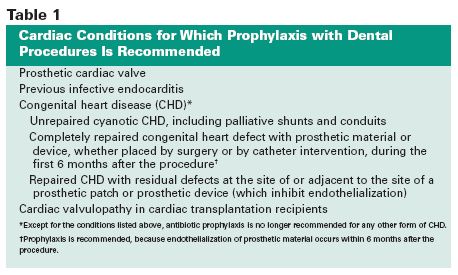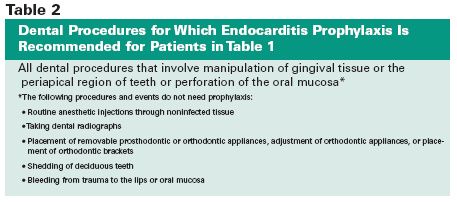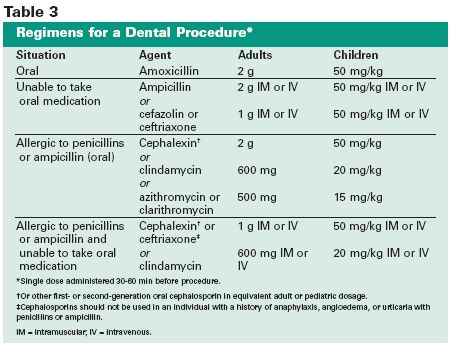Publication
Article
Pharmacy Times
Prevention of Infective Endocarditis: An Update
Author(s):
Endocarditis is defined as inflammation of the endocardium, which lines the interior of the heart and its valves. Infective endocarditis (IE) is an uncommon but life-threatening infection of the heart lining and valves.1
Recommendations have been available for a number of years for patients at risk of developing IE when undergoing a variety of procedures or tests. The American Heart Association (AHA) published its last recommendations for the prevention of IE about 10 years ago.2 In May 2007, a writing group charged by the AHA published its revised recommendations for the prevention of IE.1 The following is taken directly from selected sections of the AHA publication and highlights several issues incorporated in the new guidelines. When each section is discussed, the wording used in the AHA statements is unchanged to avoid any deviation from the original meaning of the AHA recommendations.
In these guidelines, the usual American College of Cardiology and AHA recommendation classifications and levels of evidence (LOE) were used.
Classification and LOE of Recommendations
- Class I: Conditions for which there is evidence and/or general agreement that a given procedure or treatment is beneficial, useful, and effective
- Class II: Conditions for which there is conflicting evidence and/or a divergence of opinion about the usefulness/efficacy of a procedure or treatment Class IIa: Weight of evidence/opinion is in favor of usefulness/efficacy. Class IIb: Usefulness/efficacy is less well-established by evidence/opinion.
- Class III: Conditions for which there is evidence and/or general agreement that a procedure/treatment is not useful or effective and in some cases may be harmful LOE A: Data derived from multiple randomized clinical trials or meta-analyses LOE B: Data derived from a single randomized trial or nonrandomized studies LOE C: Only consensus opinion of experts, case studies, or standard or care

Recommendations
? In patients with underlying cardiac conditions associated with the highest risk of adverse outcome from IE (Table 1), IE prophylaxis for dental procedures may be reasonable, even though we acknowledge that its effectiveness is unknown (Class IIb, LOE B)
? Antibiotic prophylaxis is recommended for patients with the conditions listed in Table 1 who undergo any dental procedure that involves the gingival tissues or periapical region of a tooth and for those procedures that perforate the oral mucosa (Table 2). Although IE prophylaxis may be reasonable for these patients, its effectiveness is unknown (Class IIb, LOE C).
? Antibiotic prophylaxis with a regimen listed in Table 3 may be considered (Class IIb, LOE C) for patients with the conditions listed in Table 1 who undergo an invasive procedure of the respiratory tract that involves incision or biopsy of the respiratory mucosa, such as tonsillectomy and adenoidectomy
? The administration of prophylactic antibiotics solely to prevent endocarditis is not recommended for patients who undergo gastrointestinal (GI) or genitourinary (GU) tract procedures, including diagnostic esophagogas-troduo-denoscopy or colonoscopy
(Class III, LOE B)


? For patients with the conditions listed in Table 1 who have an established GI or GU tract infection, or for those who receive antibiotic therapy to prevent wound infection or sepsis associated with a GI or GU tract procedure, it may be reasonable that the antibiotic regimen include an agent active against enterococci, such as penicillin, ampicillin, piperacillin, or van-comycin (Class IIb, LOE B); however, no published studies demonstrate that such therapy would prevent enterococcal IE
? For patients with the conditions listed in Table 1 scheduled for an elective cystoscopy or other urinary tract manipulation who have an enterococcal urinary tract infection or colonization, antibiotic therapy to eradicate enterococci from the urine before the procedure may be reasonable (Class IIb, LOE B). If the urinary tract procedure is not elective, it may be reasonable that the empiric or specific antimicrobial regimen administered to the patient contain an agent active against enterococci (Class IIb, LOE B).
? For patients with the conditions listed in Table 1 who undergo a surgical procedure that involves infected skin, skin structure, or musculoskeletal tissue, it is reasonable that the therapeutic regimen administered for the treatment of the infection contain an agent active against staphylococci and 3-hemolytic streptococci, such as an antistaphylococcal penicillin or a cephalosporin (Table 3 for dosage; Class IIb, LOE C).
Summary
The recent recommendations will result in fewer patients needing antibiotic prophylaxis, because IE prophylax-is should be limited to the conditions listed in Table 1 only. There is no extensive, concrete evidence that prophylax-is is effective, and, as a result, most of the AHA recommendations are categorized as Class IIb.
Dr. Tafreshi is professor and director of Cardiology Pharmacy Practice Residency at Midwestern University College of Pharmacy?Glendale (MWU-CPG), Ariz. At the time of submission of this article, Ms. Sheckler was a senior MWU-CPG pharmacy student. Dr. Kauzmeyan is a medical consultant.
References
1.Wilson W, Taubert KA, Gewitz M, et al. Prevention of Infective Endocarditis: Guidelines from the American Heart Association: A Guideline From the American Heart Association Rheumatic Fever, Endocarditis, and Kawasaki Disease Committee, Council on Cardiovascular Disease in the Young, and the Council on Clinical Cardiology, Council on Cardiovascular Surgery and Anesthesia, and the Quality of Care and Outcomes Research Interdisciplinary Working Group. Available at: http://circ.ahajournals.org/cgi/reprint/CIRCULATIONAHA.106.183095v1. Accessed May 20, 2007.
2.Dajani AS, Taubert KA, Wilson W, et al. Prevention of bacterial endocarditis: recommendations by the American Heart Association. Circulation. 1997;96:358-366.







